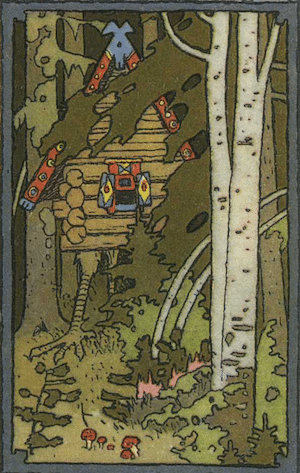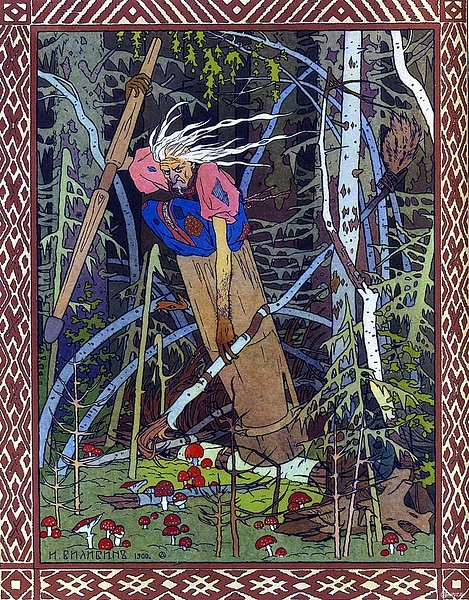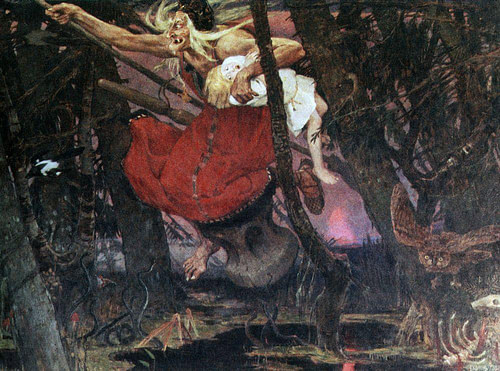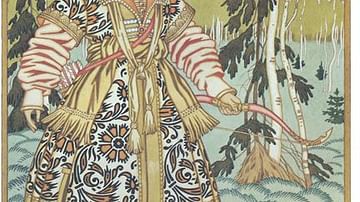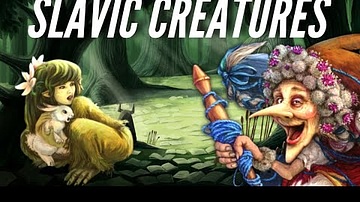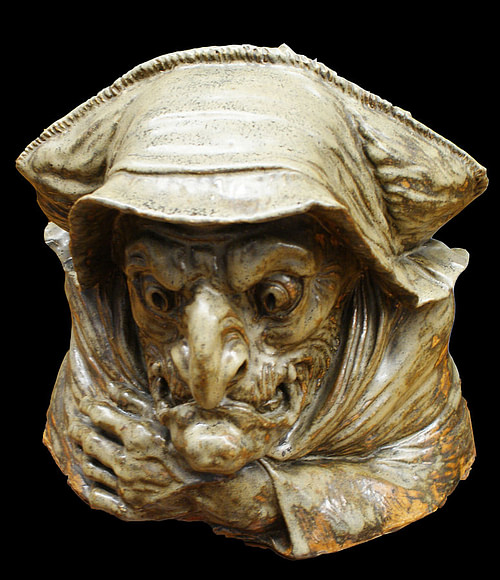
Baba Yaga (Baba Jaga) is a witch or ogress from Slavic folklore who lives in a magical hut in the forest and either helps, imprisons, or eats people (usually children). She is among the most famous figures from Slavic folklore as guardian of the fountains of the waters of life and is sometimes seen as embodying female empowerment and independence.
Her name is often understood to mean "Grandmother Witch", though this is challenged and there is no universal agreement on the meaning of Yaga. She is first mentioned in a book on Russian grammar in 1755 but is thought to have existed in the oral tradition of Slavic folktales much earlier. Although she is usually the villain of any piece she appears in, she can also offer assistance and is understood as more of a trickster character who encourages transformation than the stock figure of an evil witch.
Baba Yaga is probably best known from the story Vasilissa the Beautiful in which she inadvertently frees the heroine from the tyranny of her stepmother and stepsisters but also figures in other famous tales such as The Frog Princess and Baba Yaga and the Kind-Hearted Girl in which she is cast in a similar role. A number of her tales follow the paradigm of the Cinderella story where she plays the part of the Fairy Godmother but with a decidedly sinister twist.
As she lives outside the norms of society and always by her own rules, she has come to embody the concept of feminine power and emancipation in the modern age. Books, films, and television shows reference her today in this role, and although she retains her menacing character, she is increasingly seen as a source of wisdom and power rather than a personification of evil.
Depiction, Possible Origin, & Name
Baba Yaga is depicted as an enormous, ugly old woman who lives in a hut built on four tall chicken legs that can turn about or relocate on command. She is often seen draped over her stove or reclining in the hut across the entire expanse, with her large nose touching the ceiling. When she leaves her house, she rides in a mortar propelled by a pestle with one hand while, in the other, she holds a broom she uses to wipe away any trace of her tracks.
She usually leaves her hut in the morning, returning in the evening, and commands a flock of black geese that circle the skies looking for children. In the story Baba Yaga’s Black Geese, two disobedient children, Olga and Sergei, sneak out of their house while their mother is at the market – after she has warned them not to go out while the geese are flying – and Sergei is snatched up and brought back to Baba Yaga’s hut for her dinner. Olga is able to save her brother through the use of magical items, and the two learn their lesson about not listening to their mother.
In this story, as in many others, Baba Yaga is a powerful witch who feeds on children, but, according to scholar Andreas Johns in his comprehensive book on the subject, she may have originally been a Slavic goddess and Earth Mother. Johns cites the scholar Mikhail Chulkov who notes significant similarities between Baba Yaga and an early goddess of death known as Iagaia baba:
The Slavs venerated the underworld goddess by this name, representing her as a frightening figure seated in an iron mortar, with an iron pestle in her hands; they made blood sacrifice to her, thinking that she fed it to the two granddaughters attributed to her, and that she delighted in the shedding blood herself. (16)
Chulkov’s mention of the granddaughters of Iagaia baba reflects another similarity between the goddess and the later witch in that Baba Yaga is sometimes depicted as having two daughters or two sisters. Some scholars, in fact, refer to the figure in the plural as Baba Yagas, all essentially the same entity, their only differences the most superficial.
Other scholars believe she was initially the personification of nature, which can be cruel or kind in turns, or as a storm cloud or storm, while others have claimed she personifies a plow which breaks (injures) the earth to enable the planting, fertilization, and growth of crops. Johns cites the scholar Matthew Guthrie who seems to reject the plow interpretation in favor of the Goddess of Death theory, claiming Baba Yaga is the Slavic version of the Greek goddess Persephone.
In legend, she originates with the devil according to scholar Vasilii Levshin as cited by Johns:
Wishing to concoct the most perfect essence of evil, the devil cooked twelve nasty women together in a cauldron. To capture the essence, he gathered the steam in his mouth and then spat into the cauldron without thinking. Out of this mixture came Baba Yaga, the most perfect evil. (13)
She is usually represented along these lines, no matter what good may come of her actions, and so it could be argued that whatever may have inspired the figure is irrelevant as she became known as the personification of evil. No single interpretation of her origin is universally agreed upon, and the same is true of her name. Johns writes:
In Old Russian, the word baba could refer to a midwife, sorceress, or fortune teller, and the standard modern Russian word for "grandmother" (babushka) is derived from it. Baba in modern Russian is also a pejorative term for woman…The origin and meaning of Iaga is far more obscure and has inspired several different interpretations among linguists. (10)
Among the many possibilities suggested are disease, illness, horror, chill, wicked wood nymph, witch, evil woman, rage, fury, anger, torture, pain and worry, serpent, snake, uncle’s wife, stepmother, aunt, and mother. Johns cites scholar Brian Cooper who claims that "the name suggests a personification of suffocating oppression" and concludes that "in spite of its obscure origins, Baba Yaga’s name is well known throughout Russia. Like the word "witch", iaga was used by villagers as an unflattering designation for "old, quarrelsome, and ugly women" (11). The name can generally be understood, then, to mean "Grandmother Witch", even if that is not a direct translation.
Although she kidnaps and eats children and seems to go hunting for them throughout the day for her evening meal, Baba Yaga also serves as a catalyst for change. There are a number of tales in which she acts as an agent of transformation, helping the heroine or hero toward self-actualization and the completion of a quest. In these tales, and even in the others where she is depicted as the villain, Baba Yaga epitomizes the mythological trickster archetype.
The Trickster Figure
The trickster appears in the mythology of cultures around the world but, it should be remembered, these 'mythologies' were once understood as religious beliefs as valid as any held in the present day. The trickster was recognized as a god, or an emanation of a supreme deity, who interfered in the lives of other deities, humans, and the natural world – for whatever reason or no reason at all – encouraging transformation. However unpleasant the experience with the trickster might be, one was forced out of one’s comfort zone into a new state – often a heightened state – of awareness of oneself and the world.
One of the best-known trickster figures is Loki from Norse mythology who repeatedly antagonizes the gods of Asgard but is responsible for a number of their most prized magical items including Thor’s hammer and Odin’s spear. The trickster appears in many other belief systems, however, including as Coyote in Native American belief systems, as Esu in the Yoruba religion of West Africa, and as the Distant Goddess/Eye of Ra of ancient Egyptian religion.
The great Swiss psychiatrist Carl Gustav Jung (l. 1875-1961) has noted the similarities of these belief systems, and others, and suggests the trickster is a manifestation of another psychological archetype, the Shadow, the dark and unknown aspect of the individual and communal personality, usually rejected or suppressed. The Shadow appears in dreams, visions, religious tales, and legends representing what one fears or, at least, finds unpalatable in oneself. Jung comments:
[The trickster] is a forerunner of the savior and, like him, God, man, and animal at once. He is both subhuman and superhuman, a bestial and divine being, whose chief and most alarming characteristic is his unconsciousness. Because of it, he is deserted by his (evidently human) companions, which seems to indicate that he has fallen below their level of consciousness. (263)
Baba Yaga fits this definition neatly in that she embodies both subhuman and superhuman qualities in rejecting the consciousness of social norms and being able to act freely – unconsciously – outside of them. She is at once bestial in her hunt for prey and divine in her supernatural abilities of flight, shape-shifting, and magical spells.
Vasilissa the Beautiful
Baba Yaga as trickster is most clearly defined in the most famous of her tales, Vasilissa the Beautiful. Vasilissa lives happily with her mother and father until she is eight years old when her mother falls ill and calls her to her deathbed, giving her a magical doll to help her through life. She must always keep the doll with her, a secret from everyone else, and offer it food and drink whenever she faces some challenge in order to receive help. After her mother’s death, her father marries a woman with two daughters who is envious of Vasilissa’s beauty and abuses her, giving her harsh tasks, which her father can do nothing about since he is away on business trips. Vasilissa is only able to accomplish these tasks through the help of her doll.
Once Vasilissa and her stepsisters reach the age of marriage, the stepmother refuses all of Vasilissa’s suitors, telling them she cannot be married until her older sisters find husbands. In hopes of getting rid of Vasilissa, her stepmother keeps sending her into the woods on errands:
Now deep in this forest was a green lawn, on which stood a miserable little hut on chicken legs. In this house lived Baba Yaga, an old witch grandmother. None dared go near the hut, because Baba Yaga ate people. Vasilissa’s stepmother kept sending her into the forest in hopes that she would meet the witch and be consumed. However, the little doll showed her where the bush, flowers, and berries grew and did not let her go near the hut on chicken legs. Each time Vasilissa returned safe and sound, her stepmother hated her more and more. (Wiginton, 26)
Finally, Vasilissa is sent directly to Baba Yaga’s hut to ask for fire. She sees three riders on horseback dash past – white, red, and black – who bring twilight, sunrise, and night respectively, and arrives at Baba Yaga’s hut just before darkness falls:
Surrounding the hut was a wall of human bones topped with skulls. The gate in the wall had hinges made from the bones of human feet and locks of jawbones set with sharp teeth. Vasilissa froze in horror at the sight…Suddenly, the woods were filled with a terrible noise – trees groaning, their branches creaking and leaves rustling. Baba Yaga came flying from the forest. She rode in a large iron mortar and drove it with the pestle. As she came, she swept away her trail behind her with a kitchen broom. (Wiginton, 28-29)
Baba Yaga demands to know why the girl is there and agrees to give her fire in return for work. She assigns Vasilissa impossible tasks, which she is able to accomplish with her doll’s help. Vasilissa remains with the witch for some time as her servant and becomes curious about a number of things but is warned by Baba Yaga that "not every question leads to good" even as she allows her to ask what she will. Vasilissa understands the implied threat and only asks about the riders, seemingly enraging Baba Yaga who demands to know why she will not ask more. Vasilissa responds that she is only doing as Baba Yaga suggested and then infuriates the witch further when she is asked how she was able to perform all the tasks. She replies carefully that her mother’s blessings enabled her, and Baba Yaga, rejecting anything blessed, tells her to leave.
Baba Yaga sends her home with a skull containing the fire she was sent to fetch, and once it is brought into the house, it burns the evil stepmother and stepsisters to ashes. Afterwards, Vasilissa and her doll leave the house, she becomes a seamstress and, with the doll’s help, impresses the king so deeply that he falls in love with her, and they are married, living happily ever after.
In this tale, as in others such as The Frog Princess and Maria Morevna, Baba Yaga acts as the catalyst for transformation. The doll performs all the impossible tasks given to Vasilissa, but it is Baba Yaga who assigns them, who warns the girl against asking too many questions (and so saves her from probing too far into dangerous territory), and who provides her with the skull that sets her free from her stepmother’s cruel tyranny.
Conclusion
In The Frog Princess, Baba Yaga and her sisters play the pivotal role of helping Prince Ivan reunite with his runaway princess after he has betrayed her trust, and in Maria Morevna, it is Baba Yaga who, unwillingly, provides Prince Alexei with the horse that enables him to free his true love, Maria, from captivity. She is never depicted as kind, loving, or welcoming – except when she thinks she is meeting her evening meal – but always sparks change in the life of the central character or characters and provides the necessary elements for their transformation and liberation.
In the story of Baba Yaga and the Kind-Hearted Little Girl, a young girl and her widower father enjoy their days together until he remarries, and the stepmother ends their times together and abuses the child without the father knowing. As in the Vasilissa tale, the stepmother sends the girl into the woods hoping she will be killed by Baba Yaga, but as she goes, she shows kindness to various elements in the forest which help her escape once she reaches the hut where Baba Yaga tries to make her into a meal. Once she returns home and is forced by her father to explain where she has been, the stepmother is kicked out of the house, and the father and daughter return to their former life together.
This tale, like the others mentioned, casts Baba Yaga as the catalyst for change. Although traditionally depicted as a figure associated with darkness, evil, cannibalism, and death, Baba Yaga is essentially a transformative agent. Her rejection of societal norms frees her to act unconsciously on her desires, and as she does, she changes the lives of those who enter her sphere of influence. If one accepts Jung’s suggestion of the trickster as an embodiment of one’s Shadow, Baba Yaga represents those qualities one rejects in oneself – including selfishness, violence, spite, covetousness – which can be neutralized, once acknowledged, by the better aspects of one’s nature such as kindness, consideration, gratitude, and helpfulness; all of which are usually epitomized in the central character of the tale.
At the same time, her rejection of what is acceptable allows for others to do the same and so open themselves to the possibility of change and growth. In the present day, this aspect of her character has come to be emphasized far more than previously. She is clearly associated with the character of Khatun, symbolizing transformation and transition, in the popular Netflix series The OA and referenced, incorrectly, in the 2014 feature film John Wick starring Keanu Reeves. In both, her strength and power are emphasized over her traditional depiction as a predator. The popular 2017 book Ask Baba Yaga: Otherworldly Advice for Everyday Troubles by Taisia Kitaiskala has encouraged this understanding of the Slavic witch as a source of inspiration in understanding the importance of leaving one’s comfort zone and recognizing one’s Shadow in order to experience any kind of personal transformation.
